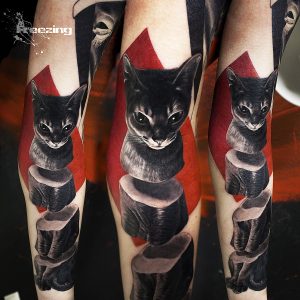The 2022 Comprehensive Guide To (Almost) Every Style Of Tattoo – Part IV
For the last part of our updated tattoo style list, we take a look at another four genres all very distinct and different from each other. You will forgive us for perhaps not covering every single style out there, and if there is something you missed in this feature, why don’t you drop us a line and tell us what you would like to see covered on the blog? Otherwise, we hope that you have perhaps found some inspiration for your new tattoo this year. Or tattoos, for that matter, why stop at just one?
Surrealism
Surrealism tattooing draws heavily from the art school of the same name. Think Salvador Dalí’s melting clocks and Frida Kahlo’s Broken Column. These works of art – whether on canvas or in ink on skin – invoke dreamlike scenarios, imagination, and the mysterious ways of the subconscious.
A good surrealist piece is not always necessarily comfortable to take in, but it will always be interesting. It is about bringing an internal vision alive via an external medium. It invites the viewer to think, rather than provide definitive answers, and will definitely be the reason for furtive glances and conversation starters for those brave enough to ask.

Trash Polka
Created by tattoo artists Simone Pfaff and Volker Merschky from Germany, Trash Polka also often draw on aforementioned surrealistic themes, but it also incorporates elements from realism and calligraphy coupled with graphic design elements. The colour palette goes mostly in black and red.
It is one of the few, if not only, styles of tattooing that has been trademarked. However, for those not able to make it to Würzburg and place themselves in the hands of Pfaff and Merschky, several artists across the world have been influenced by the pair and are allowed to create Trash Polka tattoos.
Tribal

Tribal tattooing in its true meaning comes from the word tribe, meaning that it was the original form of body art practised by tribes to mark accomplishments or prowess, show social status, or create forms of spells of protection. They were, and still are, hand-poked, used by people all over the world. Most commonly known and referenced are Maori and Polynesian traditional tattoos, however, the tradition of tattooing has existed throughout tribes all over the world.
Some artists are creating what is referred to as ‘modern tribal’, drawing on traditional patterns and elements, without copying them outright. Then, of course, there is the 90s style spiky bold and chunky style also commonly called tribal. On this side of the 20s, this is evolving into a more sophisticated and delicate version, becoming one of the predicted trends over the next couple of years.
Watercolour

Watercolour tattoos can depict any motive. As the name implies, the style mimics the essence of classic watercolour paintings – freeform, and a diaphanous appearance. Sometimes, it makes use of thin black linework, but often the edges are kept soft and borderless.
When done well, subtle colour gradients create beautiful pieces that use techniques such as blurs, bleeds, fades, and runs. The style has grown increasingly popular in the last decade, with many talented Korean artists leading the way.
